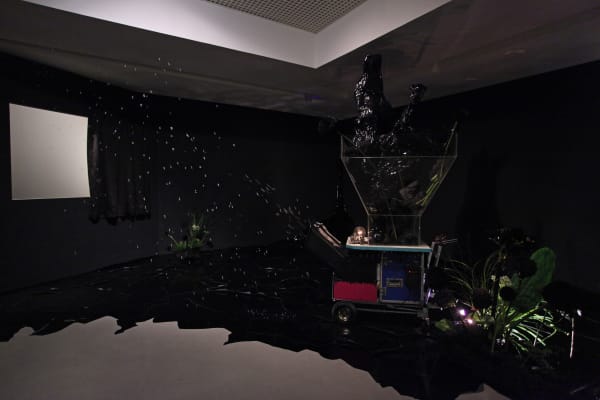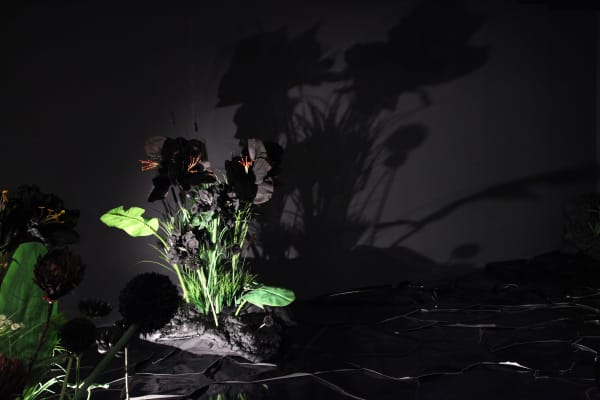Sporadic Positioning
Period | 26 April – 10 June , 2012
Venue | Arario Gallery Cheonan
Works | 42 pieces including installation, sculpture and painting
Opening Reception | 6pm, Thursday, 26 April, 2012
Participating Artists | Hyounsoo Kyung, Myungjin Song, Yongseok Oh, Eunsil Lee, Soyoung Chung, Song Jung, Jiin Ha, Sooyeon Hong
Arario Gallery Cheonan is pleased to present Sporadic Positioning, a group exhibition of eight actively practicing artists in Korea, from April 26th to June 10th, 2012. Through a total of 42 works of sculpture, painting, video and installation presenting diverse aesthetic approaches of eight artists, Sporadic Positioning provides the opportunity to assess the extensive range of artistic outlooks in Korea.
Arario Gallery Cheonan is pleased to present Sporadic Positioning, a group exhibition of eight actively practicing artists in Korea, from April 26th to June 10th, 2012.
Sporadic Positioning is a group exhibition presenting works by eight young Korean artists. The term ‘positioning’ from the title signifies re-establishing the comprehensive hypothetical images that derive from conventional notions of an actual specific subject, into properties that are distinguishably characteristic of that specific subject. Rather than acting upon a subject, positioning is about ‘situating’ the subject in the minds of the viewer. In the exhibition, eight artists continue to re-establish their positions as an artist in the art world. Repeatedly gathering and dispersing, and exchanging and severing, positioning in the works by eight artists thus reflect the sporadic and arbitrary topography of art in Korea.
Through a total of 42 works of sculpture, painting, video and installation presenting diverse aesthetic approaches of eight artists, Sporadic Positioning provides the opportunity to assess the extensive range of artistic outlooks in Korea. Furthermore, the various positioning of the eight artists encourages the audience to reflect on the current Korean art world at large from an analytical, expansive perspective.
Participating Artists
Hyounsoo Kyung b.1969
Song, Myungjin b.1973
Yongseok Oh b.1976
Lee, Eunsil b.1983
Chung, Soyoung b.1979
Jung, Song b.1985
Ha, Jiin b.1989
Hong, Sooyeon b.1967
Individual Artist Info
Hyounsoo Kyung b. 1969
Hyounsoo Kyung works on drawings and installations that reconstructs the urban space through objective data and memories. He connects the lines that appear on maps and signs that indicate specific objects in order to describe the cities we live in. In this process, Hyounsoo Kyung focuses on the visual elements that show in the map, abstracting and symbolizing them in his own way, and reproduces them on flat surfaces and cubic space. By crossing over among reality, the cartographic space, and the signs he created, he shows the relationship between the plastic world that can never signify anything, eternally.
Song, Myungjin b. 1973
The works of Myungjin Song, instigating curiosity by leaving powerful green imprints on our retina, departs from two conflicting borderline positions. She tries to define the impressions of things that are ambiguous, indefinable, or things that defy categorization; she tells us about the duality of human beings, and the insecurity of borderline positions on which they rest. The narrative of unfamiliar natural objects in the painting, giving rise to a sense of alienation in conjunction with the finger men who wander about, shows the fractions and procedures of his thinking.
Yongseok Oh b. 1976
The photographs and images Youngseok Oh creates comprise a consistent whole, created through a potential cosmos that links them together. However, what he aims to accomplish, is not weaving out order among completely different or similar things, but the impressions of scenes that cannot be clearly identified, although the relations among each image may remain within the realm of cognition. Therefore, Oh’s works cannot be read in the conventional sense, but the interlinkage among the images constituting the photograph-images could be understood. The identity of this particular relation stays indeterminate. What the viewers perceive is an unclear impression, tenuous yet tenacious – a clear cut clue for the narrative evades illumination. It is merely a synthetic landscape that straddles both photography and image, or narration and its contrary.
Lee, Eunsil b. 1983
The works of Eunsil Lee, which describe sexual or other stimulating situations in amazing detail that verges on discomfort on the part of the viewers, conveys the nuance through ambiguous hues based on aggressive yet oriental techniques. Dealing with provocative, taboo subjects, lee’s works push the viewers to make uncomfortable encounters with the images, but the fuzzy screen allows the reviewers to retain a sense of distance from the actual objects of description.
Also, traditional architectural space serves as a key motif in her work. The architectural structure in the screen consists of a surreal construct that refuses to either stay open or closed; it is almost like a door to various other worlds. The ceiling is pierced open, and the floor is nothing but thin air. These ambiguous boundaries between the doors simulate the thoughts of artists who are held prisoner within a fence without even realizing their captivation.
Chung, Soyoung b. 1979
Chung Soyoung, born in Paris, France, and a graduate of l’Ecole Nationale Supérieure des Beaux-Arts of Paris, has been working at both Seoul and Paris since 2006. Chung, working on sculpture installations that attempt to invert existing notions of space, constantly features new virtual spaces in which past and present fuse together, using countless stories that bloom and disappear in objects that are deconstructed and reorganized, buildings built and torn down. Her works, originating from her curiosity about and observation of nature, urban sceneries and the physical phenomena that take place within such spaces, can be seen as a psychological and philosophical approach to the physical force of nature, transformation, friction, crystallization, gravity and dissolution. She captures the third kind of space between nature and the artificial that does not exist in reality through her spatial experiments that cross over fields such as science, geography, architecture, and visual art.
Jung, Song b. 1985
Song Jung symbolically presents incommunicable sentiments that originate from his own experiences and memories through the color black. His drawing , which indicates a blackened yet inwardly yellow banana, refers to Asians who emulate and imitate the sensibilities of African Americans. His works come from thoughts on originality and taste. In relation to African American hip-hop culture, which is said to be “the only original culture” that came from the U.S., he mingles his experience in and obsession with black, reflecting his days growing up in Korea. Like a banana, festering, exuding dark and sticky juice as its blackened spots grow larger and larger, positive choices that aim for survival gradually turns into a negative tool that fetters its own self. The particular feeling towards black, coming from a very personal taste, signifies forced, unconscious sacrifices and endurance to the artist, weighing him down; hip-hop and black serves as a ‘self-restraining device’ to the artist, rather than a shield or haven.
Ha, Jiin b. 1989
Jiin Ha’s works are explorations of self and existence, delivered through the symbol of solitude and loneliness of islands. In this process, Ha seeks out her location at the borderlands of her own identity as recognized by others and her own self, and draws out her very own island of perfection. To Ha, individuals are floating islands, where she attempts to speak not of loneliness, but aloneness, as a philosopher Osho Rajneesh envisions it – it is a reference to one’s own being.
Hong, Sooyeon b. 1967
Her works consist of drawings and paintings expressed in the subtle and delicate nuance of black and white. What catches our eyes in her works, is their simplicity and clarity. However, her pieces show the object’s section through overlaps, based on meticulous plans and intention. Also, her works have precise and bold scopes of color. The forms are abstract, but the harmonization of the colors represents her own, organized style. She selects common forms and images, and puts them in a formation that is neither arbitrary nor causally connected. Realizing an outstanding sense of balance, she amplifies the implication that something important is going on, through peculiar combinations of forms.

































































